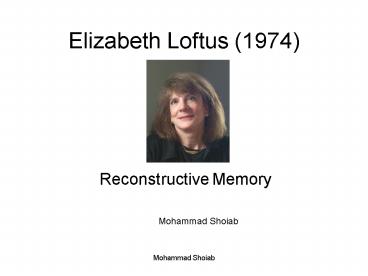Elizabeth Loftus 1974 - PowerPoint PPT Presentation
1 / 7
Title:
Elizabeth Loftus 1974
Description:
Critical question was About how fast were the cars going when they HIT each other? ... 2nd group asked 'How fast were the cars going when they smashed into ... – PowerPoint PPT presentation
Number of Views:335
Avg rating:3.0/5.0
Title: Elizabeth Loftus 1974
1
Elizabeth Loftus (1974)
- Reconstructive Memory
Mohammad Shoiab
2
- Experiment 1 Reconstructive Memory
- AimTo see how reconstructive memory would
affect their answer when questioned. - Procedure
- 50 ppts shown clips of car accidents
- Then asked questions
- Critical question was About how fast were the
cars going when they HIT each other? - Hit replaced with either smashed, collided,
bumped or contacted.
Results
3
Experiment Two - Response Bias
- Aim
- Whether or not experiment one, could be explained
by response bias. - Procedure
- 150 ppts all shown car accident
- Split into groups of 50
- 1st group asked How fast were the cars going
when they hit each other? - 2nd group asked How fast were the cars going
when they smashed into each other? - 3rd group was the control group
4
- Findings
- One week later they were asked a critical
question, Did you see any broken glass? - The 2nd group who were asked How fast were the
cars going when they smashed into each other?.
On average gave higher speed estimates and that
they recall seeing broken glass.
5
- Conclusions
- Due to questioning technique, causes memory to be
easily distorted leading to inaccurate recall - The distorted details to an event is also called
confabulation. - Limitations
- Ecological validity Used an independent
measures design which maybe due to the individual
differences. Made-up accident videos borrowed
from police, so it wasnt very convincing. - Deception Argues it was necessary to validate
findings and minimise demand characteristic. - Emotional reactions ppts may have found it very
distressing, altering there recall of the event
6
- Strengths
- Control conditions 3rd group were not asked
about accident but asked about whether they saw
broken glass or not, for reliability of results.
7
Other Experiments
- 25 incentive see if it improved recall of the
event, but results didnt affect the E.W.T. - Resisting misleading information ppts shown man
stealing red wallet from a woman's bag. 98
recall it being red when questioned. - Colour was brown when read another account.
Large majority still said it was red. - Shows that the misleading information cant be too
obvious































